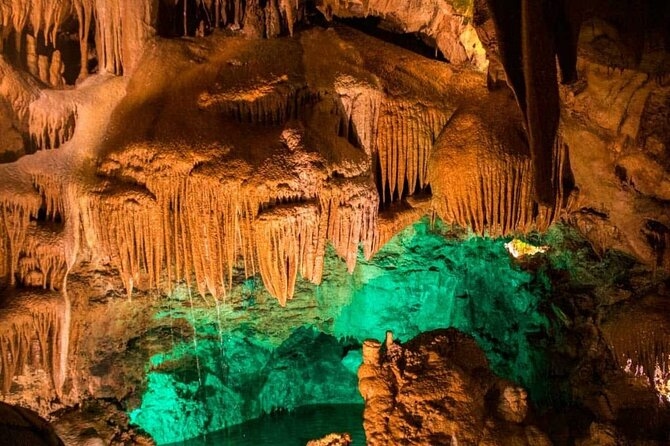
Natural Park of Serras de Aire and Candeeiros, between caves and dinosaurs
A journey through time and nature
Imagine yourself walking along winding trails, surrounded by towering limestone formations, listening to the birds singing and the murmuring of streams… pleasant, isn’t it ? The Natural Park of Serras de Aire and Candeeiros invites you on a fascinating journey through time and nature. Located in the heart of Portugal (not far from Nazaré), it’s a true open-air museum, where geology, palaeontology and biodiversity blend in perfect harmony! (And believe me, it’s impossible to leave without saying a heartfelt “wow”.)
History and evolution of the park
Created in 1979, the park covers an area of over 38,000 hectares and stretches across the districts of Leiria and Santarém. It’s part of the Maciço Calcário Estremenho, a region of extraordinary geological wealth… This limestone massif, the most important in the country, shelters more than 1,500 caves, bearing witness to a geological history that dates back over 175 million years!
Over the years, the park has evolved into a model of conservation and sustainable development. Recent projects have strengthened the local commitment to environmental protection and the promotion of responsible tourism. The creation of the “Rede de Guardiãs da Natureza” is a perfect example: a network of volunteer women and environmental educators dedicated to preserving Portugal’s national and natural parks, including Serras de Aire and Candeeiros.
This initiative successfully combines tourism and conservation: thanks to the Rede de Guardiãs da Natureza, visitors can explore the park safely and gain a deeper understanding of its richness, while the natural habitats remain protected for future generations. (And honestly, seeing local women become “guardians” of their land is truly inspiring.)
Caves, a fascinating underground world
The park is famous for its numerous caves, true natural cathedrals sculpted by water over thousands of years.
Grutas de Mira de Aire
The largest in Portugal ! They extend for 11 km, although only 600 m are open to the public, offering a breathtaking spectacle of stalactites and stalagmites. Visitors can admire impressive geological formations and beautiful lighting effects that create a magical atmosphere. (Spoiler : it’s impossible not to reach for your camera.)
.jpg?2025-10-29T00%3A20%3A02.189Z)
© bonjourlisbonne
Grutas de Alvados
Known for their unique geological formations and rich biodiversity. Less crowded, they offer a more intimate experience with nature; visitors can discover narrow galleries and halls of surprising dimensions. (Claustrophobics beware… but what a wonder!)
Grutas de Santo António
Located in Alvados, they’re ideal for a more peaceful visit. Open to the public since 1971, they are among the first Portuguese caves to have been adapted for tourism. They provide a fascinating insight into the local geology and the region’s history.
Algar do Pena
A spectacular algar (a vertical cave with an opening in the ceiling), offering a unique climbing experience. This impressive chasm is a favourite among speleologists and adventure enthusiasts !
Dinosaurs, traces of the past
The park also preserves dinosaur footprints dating back to the Middle Jurassic period, discovered in 1994 in the Galinha quarry. These fossils, now classified as a Natural Monument, bear witness to the presence of sauropods and theropods in the region, all of this over 150 million years ago !
Visitors can observe these fascinating tracks in their original geological context, providing a direct connection to Earth’s distant past… (It’s almost like walking in the footsteps of giants, literally.)
The park’s main themes
The park stands out for several key themes.
- Geology : with its limestone formations, caves and fossils.
- Biodiversity : home to a wide variety of fauna (foxes, rabbits, wild cats… and even bats!) and a rich flora, including several endemic species. The park is a haven for nature lovers, offering countless opportunities for observation.
- Cultural heritage : with its picturesque villages, pastoral traditions and dry-stone constructions. Visitors can discover the history and customs of the local communities through guided tours and cultural events. (And sometimes even join a village festival where everyone dances together, even without knowing each other.)
Expansion works and latest updates
Recently, the park has benefited from projects aimed at improving the visitor experience while preserving its ecological integrity : signposted hiking trails, informative panels, and environmental awareness campaigns. These initiatives contribute to sustainable, respectful tourism. (The kind of tourism we’d love to see everywhere, right ?)
Practical information
Access : the park is accessible by car from Lisbon in about 1h30.
Best time to visit : spring and autumn, to avoid the summer heat while enjoying the flowers in bloom or the golden autumn colours.
Recommended gear : hiking shoes, a flashlight (for cave visits), and weather-appropriate clothing. (Handy tip: check the forecast in the morning, the mountains love surprises.)
Accommodation : several options nearby, from hotels to guesthouses. Establishments such as Terruja, in Alvados, offer delicious local cuisine in a natural setting.
Restaurants : nearby villages offer excellent local cuisine, especially in Porto de Mós and Alvados. Rito Restaurante, in Porto de Mós, is particularly appreciated for its Mediterranean dishes. (And yes, we can confirm, it’s delicious !)
Visitor tips
Guided tours : to better understand the site, especially its history, joining a guided tour is highly recommended.
Respect nature : stick to the marked trails, avoid disturbing wildlife, and leave the place as pure as you found it.
Safety : some caves can be damp and slippery, so proceed with care.
Reservations : some attractions, such as the Algar do Pena, require advance booking. It’s best to plan ahead (and avoid the disappointment of finding the door closed).
A few visitor testimonials…
Those who have recently visited the park often highlight its beauty and tranquillity. One TripAdvisor user writes :
“An ideal place to recharge, far from the hustle and bustle of the big cities. The landscapes are magnificent and the caves are impressive.”
Another adds :
“The hiking trails are well maintained and offer spectacular views over the region.”
Yes, when we think of Portugal, we often picture its beaches, monuments and historic cities… but far from the crowds and tourists lies this natural wonder, raw and inspiring. (And if you’re looking for a place where you can truly breathe, look no further…you’ve found it !)
JDA
Share this article
Suggested articles

Serra da Estrela, High-Altitude Hiking in Portugal
Serra da Estrela is the highest mountain range in mainland Portugal, with Torre (its peak) reaching 1,993 metres. Located in the country’s centre, this region offers unexpectedly stunning landscapes. Here, glacial valleys, mountain lakes (frozen in winter), pine forests, and granite villages create a scene of remarkable beauty.

Montesinho Natural Park, rural and authentic Portugal
Portugal is often associated with its sun-drenched beaches, lively cities like Lisbon or Porto, or the gentle charm of the Algarve. And yet, in the northeast of the country, lies a region still little-known to most travellers: Trás-os-Montes. It’s here that you’ll find the Montesinho Natural Park, a vast protected area of over 75,000 hectares, created in 1979, and one of the largest in Portugal. Here, nature reigns supreme… yet coexists peacefully with traditional villages and locals who preserve an authentic rural way of life. It’s a unique destination for anyone wishing to discover a wilder, more genuine Portugal, and one that feels a little outside of time… in short, a breath of fresh air far from the crowds, just what we all need !

The Beaches of Nazaré and Its Giant Waves
Nazaré. The very name evokes wind, salt, and the raw power of the Atlantic. This lovely coastal town in Portugal is world-famous for its giant waves that crash onto Praia do Norte. (Yes, yes, the ones you’ve seen in all those videos of “crazy” surfers on TV.)

Paiva Walkways, Spectacular Wooden Pathways in Arouca
In the heart of Portugal, there is a place where nature becomes a spectacle at every step. A suspended path between sky, mountain and river, shaped by time and the hand of man. This extraordinary location is known as the Paiva Walkways (“Passadiços do Paiva”), situated in the municipality of Arouca. Unlike any ordinary hike, it has become a symbol of a wild and genuine Portugal, deeply connected to the beauty of its landscapes. A must-visit destination, especially since the opening of the Arouca 516 bridge experience !

Praia da Rocha, One of Portugal’s Most Iconic Beaches
There are beaches that are simply beautiful, and then there are those that become true symbols. Praia da Rocha, located in the city of Portimão in the Algarve region, unquestionably belongs to the second category. Its name, which literally translates as “Rock Beach,” hints at what makes it so spectacular: an extensive stretch of golden sand framed by striking ochre cliffs, sculpted over millennia by wind and sea. It is nature in its purest form.

Madeira island, the 25 Fontes hike
If there is one hike in Madeira island you shouldn’t miss, it is undoubtedly the 25 Fontes trail… Between lush forests, small waterfalls, birdsong and an atmosphere of mysterious woodland, this hike offers an experience that perfectly sums up what Madeira is: an island brimming with resources, combining rich nature, spectacular water displays, and total immersion. This trail is among the most famous on the island, attracting nature lovers for its scenery and unique ambience ! Here’s everything you need to know to prepare, enjoy, and avoid any pitfalls…


